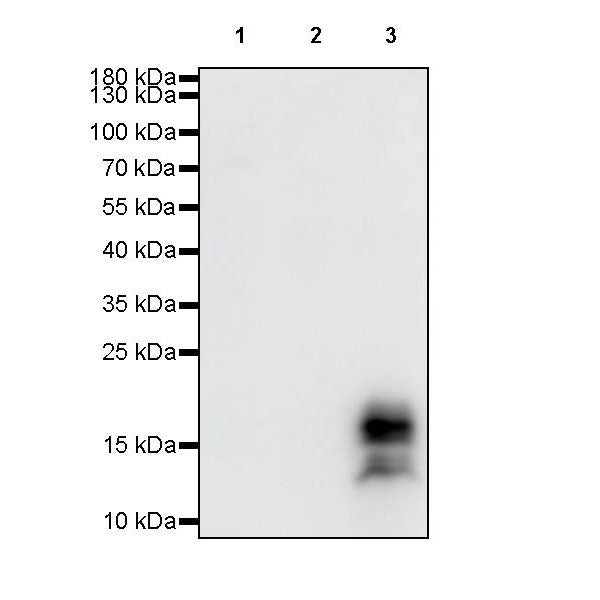WB result of GCDFP-15 Rabbit mAb
Primary antibody : GCDFP-15 Rabbit mAb at 1/1000 dilution
Lane 1 : MCF7 whole cell lysate 20 µg
Lane 2 : HepG2 whole cell lysate 20 µg
Lane 3 : T-47D whole cell lysate 20 µg
Negative control: MCF-7 whole cell lysate; HepG2 whole cell lysate 20 µg Secondary antibody: Goat Anti-Rabbit IgG, (H+L), HRP conjugated at 1/10000 dilution
Predicted MW: 17 kDa
Observed MW: 17 kDa
Product Details
Product Details
Product Specification
| Host | Rabbit |
| Antigen | GCDFP-15 |
| Synonyms | Prolactin-inducible protein, Secretory actin-binding protein (SABP), gp17, GPIP4, PIP |
| Location | Secreted |
| Accession | P12273 |
| Clone Number | SDT-R030 |
| Antibody Type | Recombinant mAb |
| Isotype | IgG |
| Application | WB, IHC-P |
| Reactivity | Hu |
| Purification | Protein A |
| Concentration | 0.25 mg/ml |
| Conjugation | Unconjugated |
| Physical Appearance | Liquid |
| Storage Buffer | PBS, 40% Glycerol, 0.05% BSA, 0.03% Proclin 300 |
| Stability & Storage | 12 months from date of receipt / reconstitution, -20 °C as supplied |
Dilution
| application | dilution | species |
| IHC-P | 1:100 | |
| WB | 1:1000 |
Background
Gross cystic disease fluid protein 15 (GCDFP-15) also known as Prolactin-inducible protein, extra-parotid glycoprotein (EP-GP), gp17 seminal actin-binding protein (SABP) or BRST2 is a protein that in humans is encoded by the PIP gene. It is upregulated by prolactin and androgens and downregulated by estrogen. The protein has a physiological function in regulation of water transport mainly in apocrine glands in the axilla, vulva, eyelid and ear canal, serous cells of the submandibular salivary gland, serous cells of the submucosal glands of the bronchi, and accessory lacrimal glands as well as cutaneous eccrine glands. It is also found in amniotic fluid and seminal fluid. PIP has the ability to bind immunoglobulin G (IgG), IgG-Fc, CD4-T cell receptor suggesting a wide range of immunological functions. PIP also binds to AZGP1. PIP exerts aspartyl proteinase activity able to cleave fibronectin. Mitogenic effect of PIP was observed on both normal and malignant breast epithelial cells.
Picture
Picture
Western Blot
Immunohistochemistry
IHC shows positive staining in paraffin-embedded human breast cancer (case 1). Anti- GCDFP-15 antibody was used at 1/1000 dilution, followed by a HRP Polymer for Mouse & Rabbit IgG (ready to use). Counterstained with hematoxylin. Heat mediated antigen retrieval with Tris/EDTA buffer pH9.0 was performed before commencing with IHC staining protocol.
IHC shows positive staining in paraffin-embedded human breast cancer (case 2). Anti- GCDFP-15 antibody was used at 1/1000 dilution, followed by a HRP Polymer for Mouse & Rabbit IgG (ready to use). Counterstained with hematoxylin. Heat mediated antigen retrieval with Tris/EDTA buffer pH9.0 was performed before commencing with IHC staining protocol.
IHC shows positive staining in paraffin-embedded human breast cancer (case 3). Anti- GCDFP-15 antibody was used at 1/1000 dilution, followed by a HRP Polymer for Mouse & Rabbit IgG (ready to use). Counterstained with hematoxylin. Heat mediated antigen retrieval with Tris/EDTA buffer pH9.0 was performed before commencing with IHC staining protocol.
Negative control: IHC shows negative staining in paraffin-embedded human breast. Anti- GCDFP-15 antibody was used at 1/1000 dilution, followed by a HRP Polymer for Mouse & Rabbit IgG (ready to use). Counterstained with hematoxylin. Heat mediated antigen retrieval with Tris/EDTA buffer pH9.0 was performed before commencing with IHC staining protocol.
Negative control: IHC shows negative staining in paraffin-embedded human kidney. Anti- GCDFP-15 antibody was used at 1/1000 dilution, followed by a HRP Polymer for Mouse & Rabbit IgG (ready to use). Counterstained with hematoxylin. Heat mediated antigen retrieval with Tris/EDTA buffer pH9.0 was performed before commencing with IHC staining protocol.
Negative control: IHC shows negative staining in paraffin-embedded human cervical squamous cell carcinoma. Anti- GCDFP-15 antibody was used at 1/1000 dilution, followed by a HRP Polymer for Mouse & Rabbit IgG (ready to use). Counterstained with hematoxylin. Heat mediated antigen retrieval with Tris/EDTA buffer pH9.0 was performed before commencing with IHC staining protocol.


